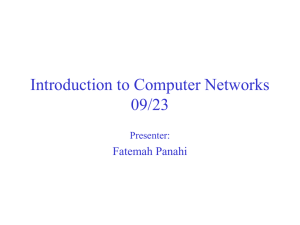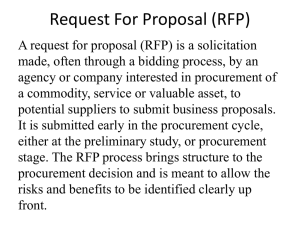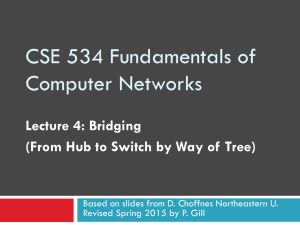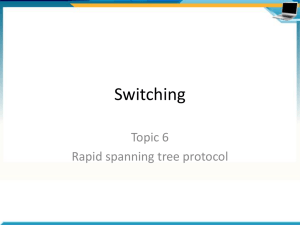Chapter 2 - Reading Organizer
advertisement
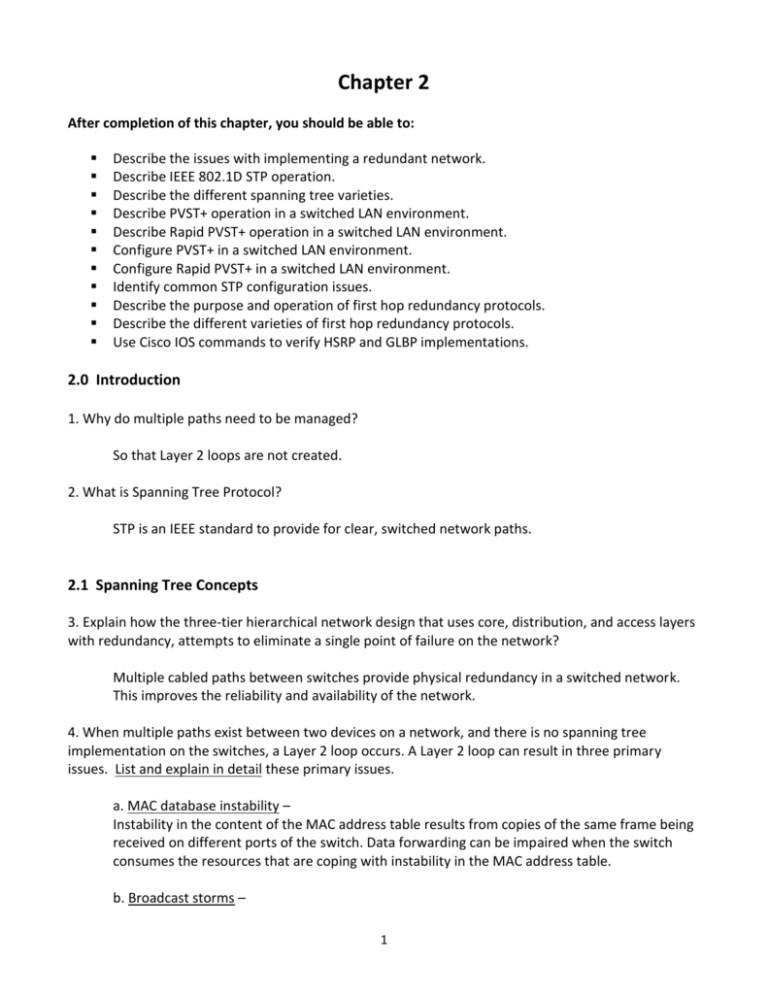
Chapter 2 After completion of this chapter, you should be able to: Describe the issues with implementing a redundant network. Describe IEEE 802.1D STP operation. Describe the different spanning tree varieties. Describe PVST+ operation in a switched LAN environment. Describe Rapid PVST+ operation in a switched LAN environment. Configure PVST+ in a switched LAN environment. Configure Rapid PVST+ in a switched LAN environment. Identify common STP configuration issues. Describe the purpose and operation of first hop redundancy protocols. Describe the different varieties of first hop redundancy protocols. Use Cisco IOS commands to verify HSRP and GLBP implementations. 2.0 Introduction 1. Why do multiple paths need to be managed? So that Layer 2 loops are not created. 2. What is Spanning Tree Protocol? STP is an IEEE standard to provide for clear, switched network paths. 2.1 Spanning Tree Concepts 3. Explain how the three-tier hierarchical network design that uses core, distribution, and access layers with redundancy, attempts to eliminate a single point of failure on the network? Multiple cabled paths between switches provide physical redundancy in a switched network. This improves the reliability and availability of the network. 4. When multiple paths exist between two devices on a network, and there is no spanning tree implementation on the switches, a Layer 2 loop occurs. A Layer 2 loop can result in three primary issues. List and explain in detail these primary issues. a. MAC database instability – Instability in the content of the MAC address table results from copies of the same frame being received on different ports of the switch. Data forwarding can be impaired when the switch consumes the resources that are coping with instability in the MAC address table. b. Broadcast storms – 1 Without some loop-avoidance process, each switch may flood broadcasts endlessly. This situation is commonly called a broadcast storm. c. Multiple frame transmission – Multiple copies of unicast frames may be delivered to destination stations. Many protocols expect to receive only a single copy of each transmission. Multiple copies of the same frame can cause unrecoverable errors. 5. Ethernet frames do not have a time to live (TTL) attribute, like IP packets. Explain what happens if there is no mechanism enabled to block continued propagation of these frames on a switched network? They continue to propagate between switches endlessly, or until a link is disrupted and breaks the loop. 6. Which switch ports are broadcast frames forwarded out of? All switch ports, except the original ingress port. 7. Explain what happens to a host caught in a network loop? It is not accessible to other hosts on the network. Additionally, due to the constant changes in the MAC address table, the switch does not know out of which port to forward unicast frames. 8. What happens when a broadcast storm occurs? There are so many broadcast frames caught in a Layer 2 loop that all available bandwidth is consumed. 9. Explain in detail the other consequences of broadcast storms. (Besides looping traffic.) Because broadcast traffic is forwarded out every port on a switch, all connected devices have to process all broadcast traffic that is being flooded endlessly around the looped network. This can cause the end device to malfunction because of the high processing requirements for sustaining such a high traffic load on the NIC. 10. Broadcast frames are not the only type of frames that are affected by loops. What are another type of frame that can be affected by routing loops? Unicast frames 11. Layer 2 LAN protocols lack a mechanism to recognize and eliminate endlessly looping frames. Some Layer 3 protocols implement a TTL mechanism that limits the number of times a Layer 3 networking device can retransmit a packet. Lacking such a mechanism, Layer 2 devices continue to retransmit looping traffic indefinitely. What was developed to address layer 2 looping issues? STP – Spanning Tree Protocol 2 12. What does STP ensure? That there is only one logical path between all destinations on the network by intentionally blocking redundant paths that could cause a loop. 13. What is required for a port to be considered blocked? A port is considered blocked when user data is prevented from entering or leaving that port. 14. If the path is needed to compensate for a network cable or switch failure what does STP do? STP recalculates the paths and unblocks the necessary ports to allow the redundant path to become active. 15. What does the following acronyms stand for? a. STP – Spanning Tree Protocol b. RSTP – Rapid Spanning Tree Protocol c. MSTP – Multiple Spanning Tree Protocol 16. According to the latest IEEE documentation on spanning tree, which version has been superseded and is outdated? STP or Spanning Tree Protocol 17. What is a BPDU? It is a messaging frame exchanged by switches for STP. 18. When the STA has determined which paths are most desirable relative to each switch, it assigns port roles to the participating switch ports. List and explain the port roles and their purpose. a. Root ports – Switch ports closest to the root bridge. Root ports are selected on a per-switch basis. b. Designated ports – All non-root ports that are still permitted to forward traffic on the network. Designated ports are selected on a per-trunk basis. If one end of a trunk is a root port, then the other end is a designated port. All ports on the root bridge are designated ports. c. Alternate and backup ports – 3 Alternate ports and backup ports are configured to be in a blocking state to prevent loops. Alternate ports are selected only on trunk links where neither end is a root port. This allows for faster transition to a forwarding state, when necessary. (Blocking ports only come into play when two ports on the same switch are connected to each other via a hub or single cable.) d. Disabled ports – A disabled port is a switch port that is shut down. 19. Explain the purpose of the root bridge? The root bridge serves as a reference point for all spanning tree calculations to determine which redundant paths to block. 20. In long winded, excruciating detail explain the process switches follow to elect a root bridge. As the switches forward their BPDU frames, adjacent switches in the broadcast domain read the root ID information from the BPDU frames. If the root ID from a BPDU received is lower than the root ID on the receiving switch, then the receiving switch updates its root ID, identifying the adjacent switch as the root bridge. Actually, it may not be an adjacent switch, but could be any other switch in the broadcast domain. The switch then forwards new BPDU frames with the lower root ID to the other adjacent switches. Eventually, the switch with the lowest BID ends up being identified as the root bridge for the spanning tree instance. 21. When the root bridge has been elected for the spanning tree instance, the STA starts the process of determining the best paths to the root bridge from all destinations in the broadcast domain. How is this accomplished? The path information is determined by summing up the individual port costs along the path from the destination to the root bridge. 22. Is the switch port cost is configurable? Yes 23. What command is used to restore the port cost back to the default value of 19? no spanning-tree cost 24. What command can be used to verify the port and path cost to the root bridge? show spanning-tree 25. Priority is the initial deciding factor when electing a root bridge. If the priorities of all the switches are the same, how is the root bridge decided? The device with the lowest MAC address becomes the root bridge. 4 26. The bridge ID (BID) is used to determine the root bridge on a network. The BID field of a BPDU frame contains three separate fields. These are: a. Bridge priority b. Extended system ID c. MAC address 27. When two switches are configured with the same priority and have the same extended system ID, what becomes the decided factor in electing the root bridge? The switch having the MAC address with the lowest hexadecimal value will have the lower BID. 28. Write in the RSTP port role name to each switch port in the topology. Port role names may be used more than once. 2.2 Varieties of Spanning Tree Protocols 29. List the varieties of spanning tree protocols have emerged since the original IEEE 802.1D. a. STP b. PVST+ c. 802.1D-2004 d. Rapid Spanning Tree Protocol (RSTP) or IEEE 802.1w e. Rapid PVST+ f. Multiple Spanning Tree Protocol (MSTP) 30. Explain the characteristics of the spanning tree protocols listed below, and indicate whether the particular spanning tree protocol is Cisco-proprietary or an IEEE standard implementation. 5 a. STP – Assumes one IEEE 802.1D spanning tree instance for the entire bridged network, regardless of the number of VLANs. Because there is only one instance, the CPU and memory requirements for this version are lower than for the other protocols. However, because there is only one instance, there is only one root bridge and one tree. Traffic for all VLANs flows over the same path, which can lead to suboptimal traffic flows. Because of the limitations of 802.1D, this version is slow to converge. b. PVST+ A Cisco enhancement of STP that provides a separate instance of the Cisco implementation of 802.1D for each VLAN that is configured in the network. The separate instance supports PortFast, UplinkFast, BackboneFast, BPDU guard, BPDU filter, root guard, and loop guard. Creating an instance for each VLAN increases the CPU and memory requirements, but allows for per-VLAN root bridges. This design allows the spanning tree to be optimized for the traffic of each VLAN. Convergence of this version is similar to the convergence of 802.1D. However, convergence is per-VLAN. c. RSTP (or IEEE 802.1w) – An evolution of spanning tree that provides faster convergence than the original 802.1D implementation. This version addresses many convergence issues, but because it still provides a single instance of STP, it does not address the suboptimal traffic flow issues. To support that faster convergence, the CPU usage and memory requirements of this version are slightly higher than those of CST, but less than those of RSTP+. d. Rapid PVST+ A Cisco enhancement of RSTP that uses PVST+. It provides a separate instance of 802.1w per VLAN. The separate instance supports PortFast, BPDU guard, BPDU filter, root guard, and loop guard. This version addresses both the convergence issues and the suboptimal traffic flow issues. However, this version has the largest CPU and memory requirements. e. MSTP – The IEEE 802.1s standard, inspired by the earlier Cisco proprietary MISTP implementation. To reduce the number of required STP instances, MSTP maps multiple VLANs that have the same traffic flow requirements into the same spanning tree instance. f. MST – The Cisco implementation of MSTP, which provides up to 16 instances of RSTP (802.1w) and combines many VLANs with the same physical and logical topology into a common RSTP instance. Each instance supports PortFast, BPDU guard, BPDU filter, root guard, and loop guard. The CPU and memory requirements of this version are less than those of Rapid PVST+, but more than those of RSTP. 30. What is the default spanning tree mode for Cisco Catalyst switches? PVST+, which is enabled on all ports. 6 31. Cisco developed PVST+ to do what? So that a network can run an independent instance of the Cisco implementation of IEEE 802.1D for each VLAN in the network. 32. To facilitate the learning of the logical spanning tree, each switch port transitions through five possible port states. List and explain each. a. Blocking – The port is an alternate port and does not participate in frame forwarding. The port receives BPDU frames to determine the location and root ID of the root bridge switch and what port roles each switch port should assume in the final active STP topology. b. Listening – Listens for the path to the root. STP has determined that the port can participate in frame forwarding according to the BPDU frames that the switch has received thus far. At this point, the switch port not only receives BPDU frames, it also transmits its own BPDU frames and inform adjacent switches that the switch port is preparing to participate in the active topology. c. Learning – Learns the MAC addresses. The port prepares to participate in frame forwarding and begins to populate the MAC address table. d. Forwarding – The port is considered part of the active topology. It forwards data frames and sends and receives BPDU frames. e. Disabled – The Layer 2 port does not participate in spanning tree and does not forward frames. The disabled state is set when the switch port is administratively disabled. 33. List the four steps that PVST+ performs to provide a loop-free logical network topology for each VLAN in a switched network. a. Elects one root bridge b. Selects the root port on each non-root bridge c. Selects the designated port on each segment d. The remaining ports in the switched network are alternate ports 34. How can a network administrator manipulate the root bridge election to select the root bridge? Assign a lower priority to the switch that needs to be the root bridge. 7 35. What is the preferred protocol for preventing Layer 2 loops in a switched network environment? RSTP 36. What is an RSTP edge port? It is a switch port that is never intended to be connected to another switch device. 37. Non-edge ports are categorized into two link types. List and explain both. a. Point-to-Point – A port operating in full-duplex mode typically connects a switch to a switch and is a candidate for rapid transition to forwarding state. b. Shared – A port operating in half-duplex mode connects a switch to a hub that attaches multiple devices. 2.3 Spanning Tree Configuration 38. What is the default spanning tree mode on a Cisco Catalyst 2960 series switch? PVST+ 39. There are two different methods to configure the bridge priority value on a Cisco Catalyst switch and force the root bridge election. Explain both methods. Method 1 – To ensure that the switch has the lowest bridge priority value, use the spanning-tree vlan vlanid root primary command in global configuration mode. Method 2 – Another method for configuring the bridge priority value is using the spanning-tree vlan vlan-id priority value global configuration mode command 40. PortFast is a Cisco feature for PVST+ environments. Explain what happens when a switch uses PortFast. When a switch port is configured with PortFast that port transitions from blocking to forwarding state immediately, bypassing the usual 802.1D STP transition states (the listening and learning states). 8 41. In addition to establishing a root bridge, it is also possible to establish a secondary root bridge. What is a secondary root bridge? A secondary root bridge is a switch that may become the root bridge for a VLAN if the primary root bridge fails. 42. Rapid PVST+ commands control the configuration of VLAN spanning tree instances. Explain what a spanning tree instance is and how it is created A spanning tree instance is created when an interface is assigned to a VLAN and is removed when the last interface is moved to another VLAN. As well, you can configure STP switch and port parameters before a spanning tree instance is created. These parameters are applied when a spanning tree instance is created. 43. There are four steps used to analyze the STP topology. Which show command is used to discover the layer 2 topology in in the first step? show cdp neighbors 44. What is a big part of troubleshooting STP? Comparing the actual state of the network against the expected state of the network and spotting the differences to gather clues about the troubleshooting problem 45. What command can be used without specifying any additional options to provide a quick overview of the status of STP for all VLANs that are defined on a switch? show spanning-tree 46. With STP, there are two types of failure. Explain both: a. STP might erroneously block ports that should have gone into the forwarding state. Connectivity might be lost for traffic that would normally pass through this switch, but the rest of the network remains unaffected. b. STP erroneously moves one or more ports into the forwarding state. 2.4 First-Hop Redundancy Protocols 47. In a switched network, each client receives only one default gateway. Why is there no secondary gateway if a second path exists? 9 There is no way to configure a secondary gateway, even if a second path exists to carry packets off the local segment. 48. One way prevent a single point of failure at the default gateway, is to implement a virtual router. Explain how this works. Multiple routers are configured to work together to present the illusion of a single router to the hosts on the LAN 49. What is first-hop redundancy? The ability of a network to dynamically recover from the failure of a device acting as a default gateway. 50. What are the steps that take place when the active router fails? a. The standby router stops seeing Hello messages from the forwarding router. b. The standby router assumes the role of the forwarding router. c. Because the new forwarding router assumes both the IP and MAC addresses of the virtual router, the host devices see no disruption in service. 51. What are the characteristics of an HSRP active router? a. Responds to default gateway’s ARP requests with the virtual router’s MAC. b. Assumes active forwarding of packets for the virtual router. c. Sends Hello messages. d. Knows the virtual router IP address. 52. What are the characteristics of GLBP? a. Allows full use of resources on all devices without the administrative burden of creating multiple groups. b. Provides a single virtual IP address and multiple virtual MAC addresses. c. Routes traffic to single gateway distributed across routers. d. Provides automatic rerouting in the event of any failure. 10


